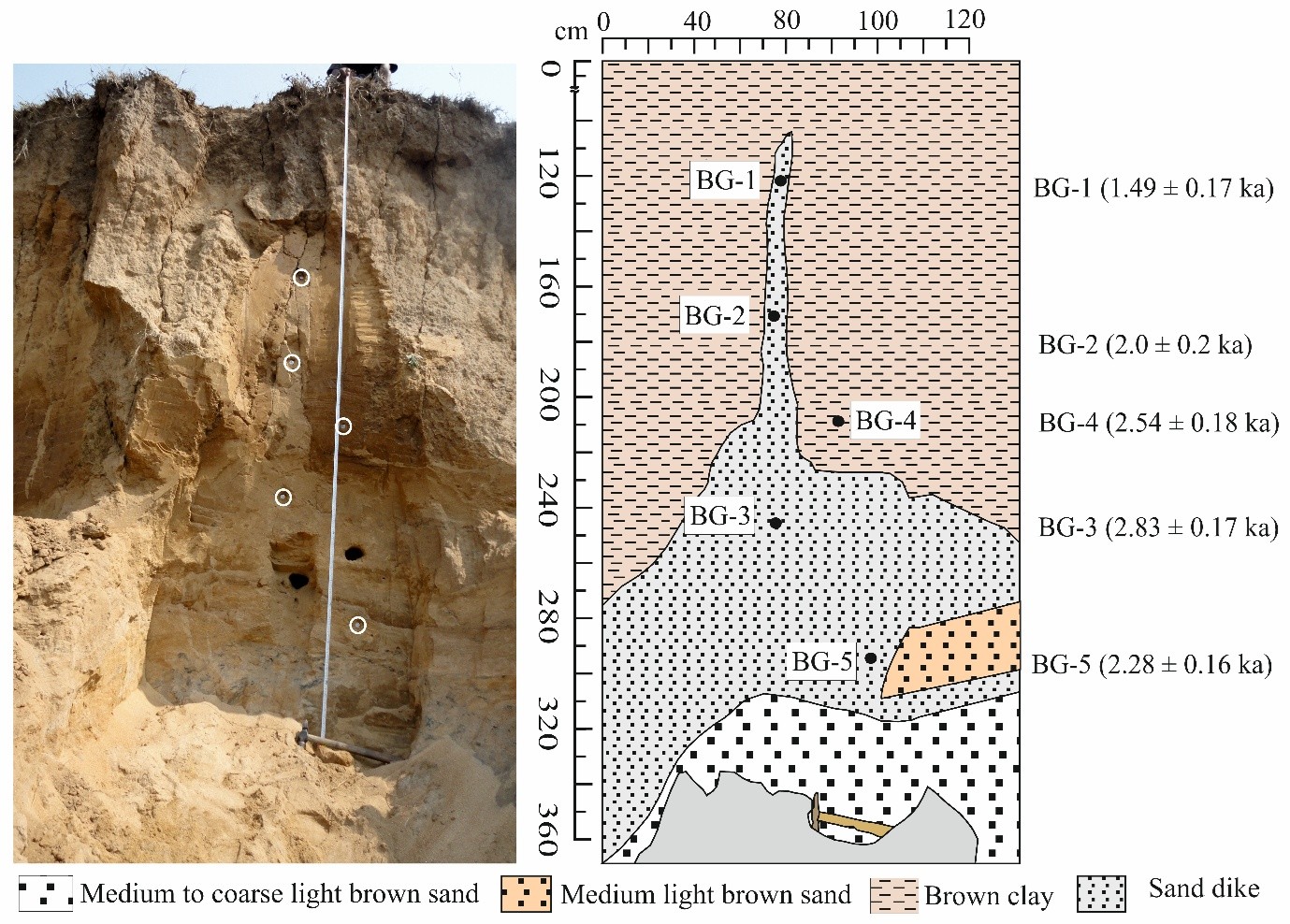Decoding Ancient Earthquakes Using Sand and Light
Dr. Sudip Karmakar
SCDD, CSIR HQ
Every earthquake leaves behind more than just cracks on the ground or damaged buildings. A few meters beneath the surface, the Earth keeps silent records of these events — in layers of sand that once moved during the shaking by earthquakes. Recently, scientists from the CSIR–National Geophysical Research Institute (NGRI), Hyderabad, along with collaborators from IPR, Gandhinagar, PRL Ahmedabad, IUAC, New Delhi, and IIT Gandhinagar, have discovered how to decipher these ancient records (doi.org/10.1016/j.epsl.2025.119578). The study, authored by A.K. Tyagi, D. Kumar, M.K. Murari, R.N. Singh, and A.K. Singhvi, focuses on sand dykes — strange, finger-like formations of sand generated beneath the ground when powerful earthquakes shake water-soaked layers below. By studying these formations and applying a light-based technique known as luminescence dating, the researchers have found a new way to tell when ancient earthquakes struck — helping unlock the seismic secrets buried beneath our feet.

View of about 0.5 to 1m thick sand dyke observed at Namgaon village in the Nagaon district of Assam (Credit: https://www.ngri.res.in/research/paleo-seismology.php)
How Earthquakes Create Sand Dykes
When the ground shakes violently, it doesn’t just move sideways or up and down. In places where the soil is loose and full of water, something interesting happens. The shaking causes the wet sand to lose its strength and act like a fluid — a process known as liquefaction.
During liquefaction, the water-saturated sand is squeezed and pushed upward through cracks in the layers above it. Once the shaking ceases, the water drains away, leaving behind thin, vertical layers of clean sand within the cracks. Over time, these buried vertical layers consolidate and become sand dykes.
A New Way to Tell Earthquake Time
Traditionally, scientists have used radiocarbon dating to bracket the age of past earthquakes by studying bits of organic material trapped in soil layers. But this approach has limitations because such material isn’t always available or is commonly affected by reworking.
The new study utilizes a technique called Optically Stimulated Luminescence (OSL) dating. This method relies on certain minerals in sand, mainly quartz and feldspar, which can store small amounts of energy from natural radiation present in the surrounding soil and rocks. Over long periods, this energy slowly builds up within the crystal structure of these minerals. The stored energy is termed as luminescence signal.
When the minerals are suddenly exposed to heat or sunlight, the stored energy is released, and the natural “clock” inside them is reset. After this, they start collecting energy again at a steady rate. By measuring the amount of energy now stored inside these mineral grains, scientists can estimate how much time has passed since the last reset — revealing when the causative geological event, such as the formation of a seismogenic sand dyke, occurred.
How Heat Resets the Clock
The researchers proposed that during the formation of a sand dyke, as the sandy fluid rushes through narrow cracks, the sand grains rub against each other intensely. This friction creates heat, similar to how rubbing your hands together warms them up.
Their calculations showed that the temperature inside these moving sediments could rise to 350–450°C — enough to erase any previously stored luminescence signal in the quartz grains. When the sand cools, the grains start accumulating energy again, beginning a new timing cycle.
To test this idea, the scientists collected sand samples from dykes in northeastern India, a region known for frequent earthquakes. They carried out laboratory experiments to measure how quartz grains responded to heat. The tests confirmed that the grains became more sensitive after being heated beyond 350°C, showing that the dyke sand had indeed experienced such temperatures during its formation.

Field photograph and corresponding stratigraphic profile of the Beltaghat sampling site -1, samples from different sedimentary units are labelled with age (Ref: doi.org/10.1016/j.epsl.2025.119578)
Afterward, the team used OSL dating to measure how much energy the quartz grains had built up since they were last heated. This allowed them to determine the approximate ages of the earthquakes that created the dykes. The results pointed to three major seismic events — one about 300 years ago, another around 1,000 years ago, and one over 1,500 years old.
Importance of this finding
This new approach provides a direct way to date earthquakes by analyzing the sand itself, rather than relying on external materials. It gives scientists a more accurate timeline of when large quakes occurred in a region.
Understanding the history of earthquakes is an essential part of paleoseismology, the science of studying past seismic events. It helps researchers estimate how often earthquakes happen and identify regions that may face higher risks in the future. Such knowledge plays a key role in improving earthquake hazard assessments, building design standards, and disaster preparedness. The method also fills an important gap in earthquake research. While radiocarbon dating works well for organic remains, OSL dating directly connects the age measurement to the earthquake event itself — the moment when the sand dyke formed.
Reading Earth’s Past Through Sand
Each sand dyke is like a silent record — a reminder of how the Earth once moved. By studying these structures carefully, scientists are learning to interpret the signs of ancient earthquakes that occurred long before humans could record them.
The new luminescence-based method adds an important page to this story. It shows that even the smallest grains of sand can hold valuable information about our planet’s dynamic history and help us prepare for its future movements.

 Pensioners Corner
Pensioners Corner Screen Reader Access
Screen Reader Access Skip to main content
Skip to main content






















